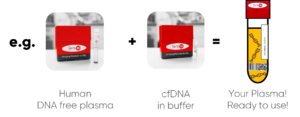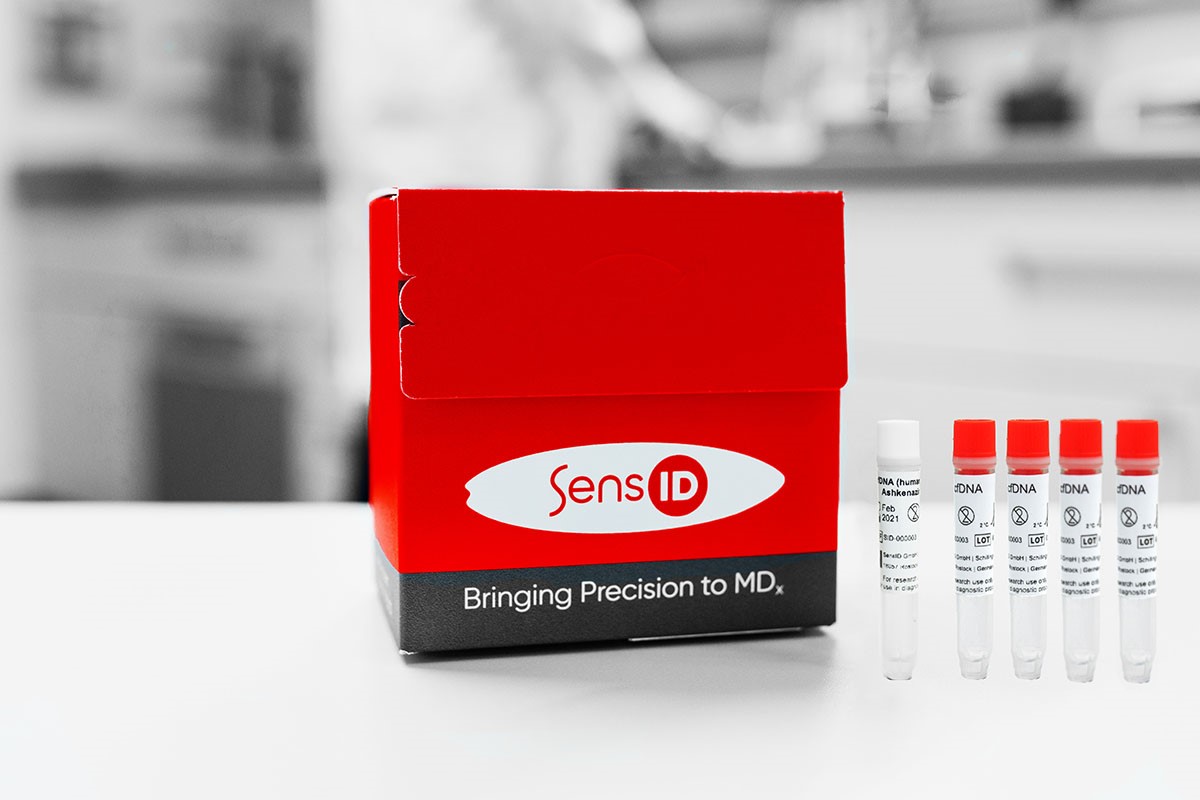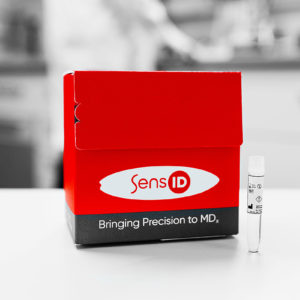Product description
The ESR1 and PIK3CA mutations have been carefully selected to cover the most clinically relevant variants. With this control material, scientists and diagnosticians can improve the sensitivity and specificity of their detection methods while ensuring consistent performance.
The material can be diluted with wild-type DNA (wt) as needed to achieve the desired allele frequency. The corresponding wild-type DNA is already included in the set. Additionally, the material is ideal for use in minimal residual disease (MRD).
- Combination of Mutations: By combining ESR1 and PIK3CA mutations in a single product, efficient and time-saving quality control is enabled.
- Flexibility in Application: The material has been specifically optimized for highly sensitive methods such as NGS and digital PCR, ensuring precise results with minimal background noise.
- Optimal Reproducibility: Manufacturing follows strict quality guidelines to ensure consistent performance and minimal batch-to-batch variability.
- Applications: Perfectly suited for clinical studies, research, validation.
This product includes the following set of separate vials:
| SID-Ref | Gene | COSMIC ID | Type of mutation | Amino acid change | Localisation in Genome (GRCh38) | HGVS Nomenclature |
| SID-000158 | ESR1 | COSV52782264 | Substitution | p.E380Q | 6:152011697-152011697 Exon 5 |
c.1138G>C |
| ESR1 | COSV52782924 | Substitution | p.Y537C | 6:152098788-152098788 Exon 8 |
c.1610A>G | |
| PIK3CA | COSV55873209 | Substitution | p.E545A | 3:179218304..179218304 Exon 9 |
c.1634A>C | |
| PIK3CA | COSV55874020 | Substitution | p.C420R | 3:179210192..179210192 Exon 7 |
c.1258T>C | |
| SID-000159 | ESR1 | COSV52782930 | Substitution | p.L536P | 6:152098785-152098785 Exon 8 |
c.1607T>C |
| ESR1 | COSV52783938 | Substitution | p.Y537S | 6:152098788-152098788 Exon 8 |
c.1610A>C | |
| PIK3CA | COSV55873227 | Substitution | p.E542K | 3:179218294..179218294 Exon 9 |
c.1624G>A | |
| PIK3CA | COSV55876869 | Substitution | p.Q546R | 3:179218307..179218307 Exon 9 |
c.1637A>G | |
| SID-000160 | ESR1 | COSV52787207 | Substitution | p.L536R | 6:152098785-152098785 Exon 8 |
c.1607T>G |
| ESR1 | COSV52781024 | Substitution | p.D538G | 6:152098791-152098791 Exon 8 |
c.1613A>G | |
| PIK3CA | COSV55873239 | Substitution | p.E545K | 3:179218303..179218303 Exon 9 |
c.1633G>A | |
| PIK3CA | COSV55876499 | Substitution | p.H1047Y | 3:179234296..179234296 Exon 20 |
c.3139C>T | |
| SID-000161 | ESR1 | COSV52784970 | Substitution | p.S463P | 6:152094402-152094402 Exon 7 |
c.1387T>C |
| ESR1 | COSV52784978 | Substitution | p.Y537N | 6:152098787-152098787 Exon 8 |
c.1609T>A | |
| PIK3CA | COSV55873220 | Substitution | p.E545G | 3:179218304..179218304 Exon 9 |
c.1634A>G | |
| PIK3CA | COSV55873195 | Substitution | p.H1047R | 3:179234297..179234297 Exon 20 |
c.3140A>G | |
| SID-00162 | ESR1 | wildtype | ||||
| PIK3CA | wildtype | |||||
ESR1 Mutations:
Mutations in the ESR1 gene are recognized biomarkers for endocrine resistance in hormone receptor-positive breast cancer. They frequently occur after therapy with aromatase inhibitors and play a central role in monitoring therapy response and resistance development.
PIK3CA Mutations
PIK3CA mutations are among the most common genetic alterations in breast cancer and other solid tumors. These mutations are predictive markers for the efficacy of PI3K inhibitors and are becoming increasingly significant in personalized medicine.
The combination of both mutations in a single control material allows for comprehensive evaluation and optimization of molecular diagnostic tests.
Buffer: Tris-EDTA (10 mM Tris, 1 mM EDTA), pH 8.0
Storage: 2–8 °C
Shelf Life: Stable up to 24 months from the date of manufacture (as supplied)
Quality Assurance
- Concentration: 10.0 ng/μl
- DNA quantity per vial with mutated DNA: 250 ng
- DNA quantity per vial with wild-type DNA: 1250 ng
- Fragment size determination: TapeStation electrophoresis (Agilent)
- Allele frequency/copy number: dPCR (metrologically recognized primary reference measurement method) (3)
- Quantification (metrologically traceable) via fluorometric dsDNA measurement (Qubit)
Technical Background
Wild-type cfDNA for the specified ESR1 and PIK3CA mutations (GRCh38).
Use as a Complete Workflow Control Material
For full workflow controls, we recommend using our human DNA-free plasma products. Mix the DNA with DNA-free plasma as needed to produce plasma materials with the required DNA concentrations.

Link to DNA-Free Plasma Products
OEM Options
If you need materials as in-kit controls or as third-party controls for the validation of your kits in customer laboratories, please contact us at: sales@sens-id.com
For Use with LDTs for:
- Evaluation of test accuracy
- Verification of analytical sensitivity and specificity
- Validation of new batches and reagents
- Ensure quality assurance
- Error analysis and troubleshooting
- When developing and performing LDTs for identifying therapeutically relevant mutations in DNA, the use of QCMs is especially important to ensure result reliability and patient safety.
Additional Information
In several retrospective cohorts, mutations in estrogen receptor 1 (ESR1) were identified in approximately 11%-55% of patients with estrogen receptor (ER)-positive metastatic breast cancer treated with aromatase inhibitors (AI) (1).
According to the results of the randomized Phase III EMERALD trial, progression-free survival (PFS) was prolonged in all patients (Hazard Ratio = 0.70; 95% CI, 0.55 to 0.88; P = .002) and in patients with ESR1 mutations (Hazard Ratio = 0.55; 95% CI, 0.39 to 0.77; P = .0005). Elacestrant is the first oral selective ER degrader to demonstrate significant PFS improvement compared to standard of care (SOC) in both the overall population and in patients with ESR1 mutations with manageable safety in a Phase III trial of ER-positive/HER2-negative advanced breast cancer (2).
PIK3CA mutations occur in approximately 40% of patients with hormone receptor (HR)-positive, HER2-negative breast cancer, with mutations primarily located in exons 9 and 20. PIK3CA mutations are also prevalent in other tumor entities, including endometrium, colon, urinary tract, cervix, and uterus (4–8).
References
- Clinical Implications of Monitoring ESR1 Mutations by Circulating Tumor DNA in Estrogen Receptor Positive Metastatic Breast Cancer: A Pilot Study
- Elacestrant (oral selective estrogen receptor degrader) Versus Standard Endocrine Therapy for Estrogen Receptor-Positive, Human Epidermal Growth Factor Receptor 2-Negative Advanced Breast Cancer: Results From the Randomized Phase III EMERALD Trial
- Assessment of Digital PCR as a Primary Reference Measurement Procedure to Support Advances in Precision Medicine
- The Cancer Genome Atlas Network. Comprehensive molecular portraits of human breast tumours. Nature. 2012;490(7418):61-70.
- Tolaney S, Toi M, Neven P, et al. Presented at: 2019 American Association for Cancer Research (AACR) Annual Meeting; March 29 – April 3, 2019; Atlanta, GA.
- Di Leo A, Johnston S, Seok Lee K, et al. Buparlisib plus fulvestrant in postmenopausal women with hormone-receptor-positive, HER2-negative, advanced breast cancer progressing on or after mTOR inhibition (BELLE-3): a randomised, double-blind, placebo-controlled, phase 3 trial. Lancet Oncol. 2018;19(1):87-100.
- Moynahan ME, Chen D, He W, et al. Correlation between PIK3CA mutations in cell-free DNA and everolimus efficacy in HR+, HER2− advanced breast cancer: results from BOLERO-2. Br J Cancer. 2017;116(6):726-730.
- Ebubekir Dirican, Mustafa Akkiprik & Ayşe Özer. Mutation distributions and clinical correlations of PIK3CA gene mutations in breast cancer. Tumor Biol. 2016. Volume 37, pages 7033–7045





